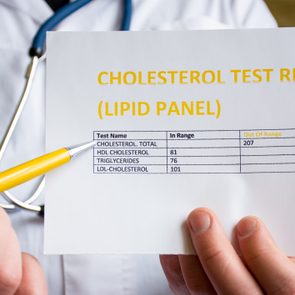This Chart Shows Healthy Cholesterol Levels by Age
Updated: Mar. 01, 2024
You can lower your risk of heart disease, stroke, and heart attacks by controlling cholesterol. Use this chart to find out the healthy and unhealthy cholesterol levels by age.
You and your cholesterol level
It’s a common misconception that all cholesterol is inherently bad for your health—based on warnings from health authorities, that’s probably no surprise. It’s why doctors field so many questions like “Is my cholesterol too high?” and “Can you give me a healthy cholesterol level by age chart?”
But not all cholesterol is bad. Actually, it’s an important substance that helps build new cells. Cholesterol is also the precursor to, or a molecule that is later converted into, vitamin D, steroid hormones, and bile salts. Bile salts are compounds the gallbladder releases into the small intestine during digestion that help break down and absorb dietary fats.
So why does cholesterol have such a bad reputation? As the level of cholesterol circulating in someone’s blood increases, so does their risk of heart disease and heart events like a heart attack or stroke.
That’s why it is so important to monitor your cholesterol levels and work to keep them in a healthy range. Of course, to do that, you need to know how to monitor your levels and what good, borderline, and bad cholesterol levels mean.
Keep reading for the lowdown on cholesterol levels, including handy cholesterol level by age charts that’ll help you navigate the ideal targets for you.
What is cholesterol?
Cholesterol is a fat-like compound with a waxy consistency. The liver produces enough cholesterol to meet all of the body’s needs. The rest of cholesterol in the body comes from foods we eat, primarily animals products (which are high in saturated fat) and processed foods (which are loaded with both saturated and trans fats).
Because cholesterol isn’t water soluble (and blood is mostly water), it can’t travel solo in the blood. So it joins up with proteins, which transport it throughout the body and to the cells.
These particles are called lipoproteins, named for the combination of fats—or lipids—and protein. There are two main types: High-density lipoproteins (HDL) and low-density lipoproteins (LDL).
This Natural Sweetener May Lower Cholesterol and Blood Sugar, New Study Says
How does cholesterol cause health problems?
When too much LDL (“bad”) cholesterol is in the bloodstream, it can stick to the inner walls of the blood vessels, particularly those that supply the brain and heart. Cholesterol can also bond with other molecules in the bloodstream before depositing on the inside of blood vessel walls.
Over time, these fatty deposits, called plaque, can narrow blood vessels and make them less flexible. As a result, it takes more force to push blood through them, which can raise blood pressure. When blood vessels narrow and become hard from plaque buildup, the condition is called atherosclerosis.
The condition is behind issues like coronary heart disease, carotid artery disease, and peripheral vascular disease. However, narrowing arteries isn’t the only way cholesterol—and the plaque buildup it can cause—is detrimental to your health.
Chunks of plaque can also loosen and become stuck in, or even block, smaller blood vessels. This can reduce or prevent blood flow. As you can probably imagine, that’s not a good thing. If tissues are starved of oxygen-rich blood, they can become damaged or destroyed. Plaque that clogs the arteries of the heart or brain can lead to a heart attack or stroke. And a pulmonary embolism, which can be fatal, can develop if pieces of plaque block tiny blood vessels in the lungs.
The Best and Worst Diets for Your Cholesterol, Says UCLA Cardiologist
What raises the risk of unhealthy cholesterol levels?
Many different factors can influence someone’s cholesterol level or certain components of it. Some of the most common risk factors for unhealthy cholesterol levels include:
- Eating too much saturated and trans fats
- A sedentary lifestyle
- Type 2 diabetes, metabolic syndrome, and insulin resistance
- Smoking
- Obesity and being overweight
- Genetics
- Alcohol consumption
- Consuming too much sugar, especially refined sugars
- Inflammatory conditions such as lupus and arthritis
- Chronic kidney disease
- Pregnancy
- Certain medications
If You Have High Cholesterol, Limit These 7 Foods

Can children have high cholesterol?
Unfortunately, children can have high or unhealthy cholesterol levels. In fact, in the United States, an estimated 50% of children and adolescents ages 6 to 19 have cholesterol levels that are not ideal, while 25% are in the high range clinically according to a 2019 study published in the Journal of the American Medical Association.
“Genetic factors and obesity may cause unhealthy cholesterol levels in children,” says Dr. Fleg.
A rare genetic condition called familial hypercholesterolemia is the most common inherited cardiovascular condition. It leads to very high cholesterol levels beginning at a young age.
4 Signs of High Cholesterol You Should Know About
When to get your cholesterol levels checked
Unhealthy cholesterol levels can be impossible to detect without the use of blood tests because they do not normally cause any obvious symptoms. That’s why heart experts call high cholesterol a silent killer.
It’s a common problem. In 2015–2016, roughly 12% of American adults ages 20 and older had high total cholesterol levels, according to the Centers for Disease Control and Prevention (CDC). And more than 18% had low HDL (“good”) cholesterol levels.
Of the US adults who could improve their cholesterol levels with medication, only a little over half are doing so. Getting proper treatment for your high cholesterol is one of the reasons it is so important to routinely check your levels.
How often you need a cholesterol test depends on your age and risk of developing unhealthy cholesterol levels.
A Heart Doctor’s New, More Affordable Alternative for Statins
Cholesterol testing in children
“The American Heart Association [AHA] recommends all children have their cholesterol first tested between ages 9 and 11 years old. Children with a family history of high cholesterol, diabetes, or obesity should get their cholesterol first tested between ages 2 and 8 years old,” says Roxana Ehsani, a registered dietitian nutritionist and spokesperson for the Academy of Nutrition and Dietetics.
Kids with a strong family history or very high risk of coronary heart disease, stroke, high blood pressure, and chronic kidney disease should also have their cholesterol levels checked as early as 2 years of age, says Jerome L. Fleg, MD, medical officer in the division of cardiovascular sciences at the National Heart, Lung, and Blood Institute.
After that, children are generally tested again between ages 17 and 21, according to the CDC.
The 3 Foods This Cardiologist NEVER Eats—and 5 Foods He Eats Every Day
Cholesterol testing in adults
Most adults need to have their cholesterol checked every five years, says Dr. Fleg. Certain people may need more frequent cholesterol tests though, such as anyone who:
- has a condition that raises the risk of unhealthy cholesterol levels
- has cardiovascular disease
- is currently trying to improve their cholesterol levels
- has a family history of high cholesterol
Cholesterol levels change with age. The older you get, the more likely you are to have high cholesterol.
How to get your cholesterol levels checked
You can buy a test kit that will allow you to check your cholesterol levels at home, but they vary in how accurate they are. Kits that are approved by the FDA and say they’re traceable to a CDC program may be more reliable.
Given the lack of quality control on home health measurements like at-home testing kits, Dr. Fleg says, blood lipids should be measured by an accredited medical laboratory. The AHA agrees, recommending that a primary care or family doctor assess blood lipid test results.
Getting an accurate cholesterol number is just one aspect of your overall cardiovascular health, though. You also have to understand what the number means for you personally. Being informed about your own health history, your family’s health history, and other potential risk factors, your doctor will be able to interpret the results better than a test kit. And by keeping track of all your cholesterol readings, your doctor will be able to catch any changes and advise you the best ways to address them.
This Nightly Habit Could Reduce Your Risk of Heart Disease, Says New Study
Preparing for your cholesterol test
Your doctor or nurse will tell you if there is anything special you need to do in the days before your blood is drawn for the test. How you’ll prepare depends on the types of cholesterol test your doctor ordered.
Non-fasting blood lipid tests analyze only total cholesterol and HDL cholesterol. If you’re getting this type of test, you can eat, drink, and take medication as usual.
Fasting lipid panels give you the whole picture when it comes to your cholesterol levels. For this test, you’ll need to fast—avoid food and drink, except plain water—and go off medications for nine to 12 hours before the test.
Here’s How Often You Should Actually Take Your Blood Pressure, According to a Cardiologist
What is included in a cholesterol test?
A doctor will order a basic blood lipid or blood lipoprotein test to check your cholesterol levels. These tests determine the milligrams of cholesterol per deciliter of blood (mg/dl, while a blood lipid panel will normally assess someone’s levels of several types of cholesterol, including the following.
Total Cholesterol
Total blood (serum) cholesterol measures the concentration of all types of cholesterol in the blood. It is calculated by adding your LDL and HDL levels, plus 20% of your triglyceride level.
According to the AHA, having “normal” total cholesterol levels is not as important as your overall risk of developing cardiovascular disease or heart events.
HDL cholesterol
Often referred to as good cholesterol, high-density lipoproteins are molecules that are not fully saturated with hydrogen molecules. Because they are not saturated, HDL cholesterol can pick up freely circulating LDL cholesterol and carry it to the liver, which removes it from the body.
It’s a good thing that HDL mops up excess LDL, but it generally doesn’t clean up all the bad cholesterol. Only one-third to one-fourth of cholesterol is carried to the liver by HDL, according to the AHA.
Experts say many people have HDL levels that are too low. And while women often have naturally higher levels of HDL than men, this can change after menopause, when estrogen levels drop.
Men may show a modest increase in their HDL cholesterol levels through middle age, says Dr. Fleg.
LDL cholesterol
Normally considered bad cholesterol, LDL builds up in the blood and can lead to plaque deposits and atherosclerosis. This, in turn, can result in heart disease and other dangerous health conditions.
When doctors talk about lowering your cholesterol, they’re referring, in part, to reducing LDL cholesterol.
22 Foods That Can Help Lower Blood Pressure
Triglycerides
The most common fats found in the body are called triglycerides. Some are produced by the body; the rest come from the foods we eat. These fat molecules store extra energy from food.
People with high triglyceride levels tend to have low HDL levels as well, a one-two punch to your heart health.
Non-HDL cholesterol
Your lipid panel may go beyond the big four numbers (LDL, HDL, triglycerides, and total cholesterol), also including non-HDL cholesterol. You calculate it by subtracting HDL from total cholesterol level.
In other words, your non-HDL cholesterol level reflects all types of fat in your blood except for HDL. Zeroing in on only the bad fats may help your doctor assess your heart disease risk, according to some experts.
VLDL cholesterol
In some cases, a lipid panel may look at your levels of very-low-density lipoprotein (VLDL). Like LDL cholesterol, VLDL cholesterol can contribute to the formation of plaque inside blood vessel walls and raise the risk of cardiovascular disease.
Eating This Nut May Reduce Heart Disease Risk, New Study Says
| Healthy Cholesterol Levels By Age | ||
| Adults age 20 or older | People age 19 or younger | |
| Total Cholesterol | Less than 200 mg/dl | Less than 170 mg/dl |
| LDL | Less than 100 mg/dl | Less than 110 mg/dl |
| HDL | Men: 40 mg/dl or higher Women: 50 mg/dl or higher Ideal: 60 mg/dl or higher |
45 mg/dl or higher |
| Triglycerides | Less than 149 mg/dl | Age 9 or younger: less than 75 mg/dl Ages 10-19: less than 90 mg/dl |
| Non-HDL | Less than 130 mg/dl | Less than 45 mg/dl |
Cholesterol levels by age charts
Healthy cholesterol targets vary based on age, with different targets for adults, young children, and adolescents.
The numbers below are good, borderline, and high cholesterol levels for adults and children, according to Dr. Fleg, AHA guidelines, and the National Institutes of Health’s National Library of Medicine.
Total cholesterol levels by age chart
| Adults age 20 or older | People age 19 or younger | |
| Good | Less than 200 mg/dl | Less than 170 mg/dl |
| Borderline | 200 to 239 mg/dl | 170 to 199 mg/dl |
| High | 240 mg/dl or higher | 200 mg/dl or higher |
LDL cholesterol levels by age chart
| Adults age 20 or older | People age 19 or younger | |
| Good | Less than 100 mg/dl | Less than 110 mg/dl |
| Borderline | 130 to 159 mg/dl | 110 to 129 mg/dl |
| High | 160 mg/dl or higher | 130 mg/dl or higher |
HDL cholesterol levels by age chart
| Adults age 20 or older | People age 19 or younger | |
| Good | Men: 40 mg/dl or higher Women: 50 mg/dl or higher Ideal: 60 mg/dl or higher |
45 mg/dl or higher |
| Borderline | n/a | 40 to 45 mg/dl |
| Low | Less than 40 mg/dl | Less than 40 mg/dl |
Triglyceride levels by age chart
| Adults age 20 or older | People ages 10-19 | Children ages 9 and younger | |
| Good | Less than 149 mg/dl | Less than 90 mg/dl | Less than 75 mg/dl |
| Borderline | 150 to 199 mg/dl | 90 to 129 mg/dl | 75 to 129 mg/dl |
| High | 200 mg/dl or higher | 130 mg/dl or higher | 100 mg/dl or higher |
Non-HDL cholesterol levels by age chart
| Adults age 20 or older | People age 19 or younger | |
| Good | Less than 130 mg/dl | Less than 45 mg/dl |
| Borderline | n/a | 120 to 144 mg/dl |
| High | n/a | 145 mg/dl or higher |
When it comes to VLDL cholesterol in adults, a healthy level is less than 30 mg/dl.
A UCLA Heart Doctor Just Shared the Age When Many Women’s Heart Disease Risk Increases
How to improve unhealthy cholesterol levels
High cholesterol may be dangerous, but the good news is that there are steps you can take to lower your cholesterol levels. One major way to do that is by engaging in a heart-healthy lifestyle.
“While it helps to follow a healthy lifestyle from an early age, you’re never too old to change your lifestyle for the better and help protect your heart health,” says Jen Bruning, a spokesperson for the Academy of Nutrition and Dietetics.
One of the best ways to improve your cholesterol is to follow a diet that limits foods high in saturated fat and eliminates trans fats. Other tips for changing unhealthy cholesterol levels include:
- Eat mostly monounsaturated fat and polyunsaturated fats. These healthy fats are found in most non-tropical plant-based oils (like olive, canola, and sunflower), nuts and seeds, and fatty fish like salmon and trout.
- Exercise regularly.
- Quit smoking.
- Cut back on alcohol.
- Eat fewer added sugars.
- Drink enough water.
- Avoid being sedentary for too long by taking short breaks while sitting.


















